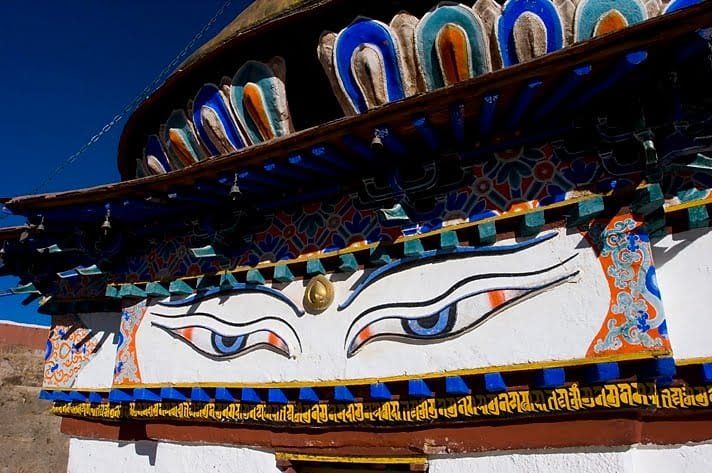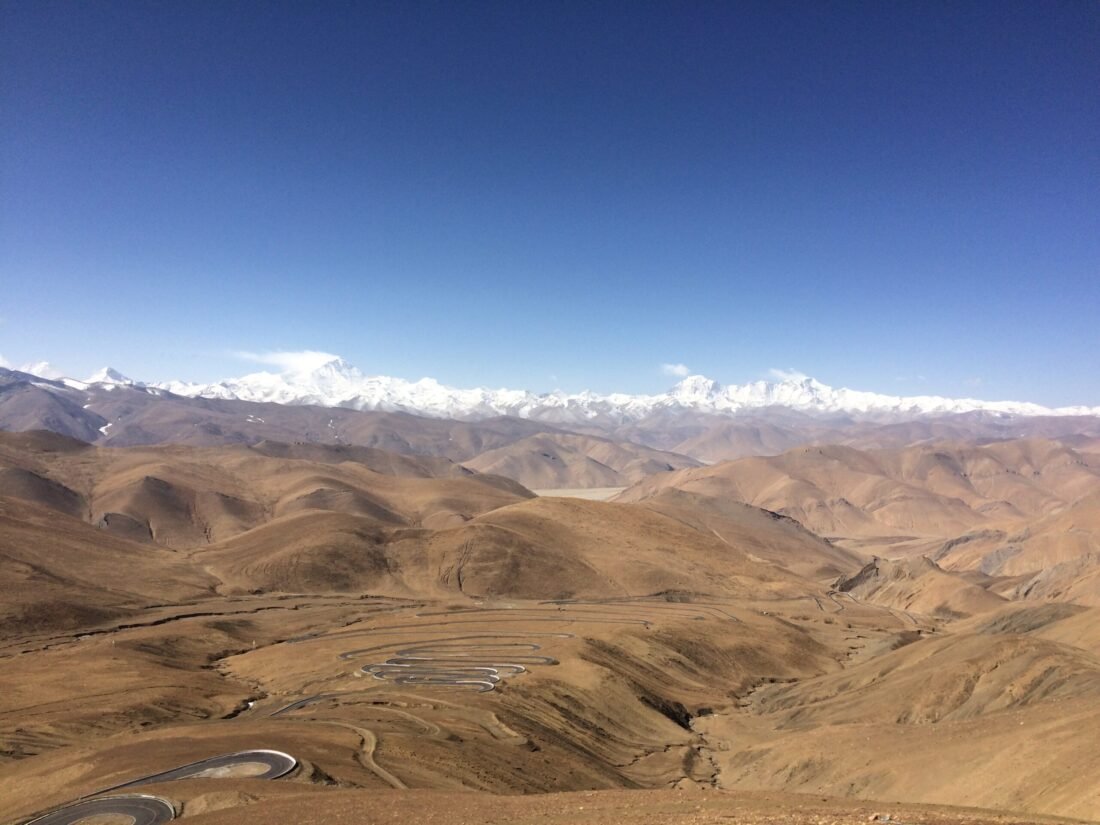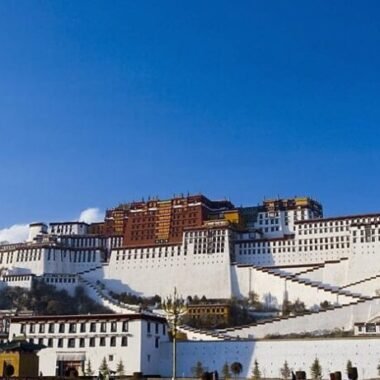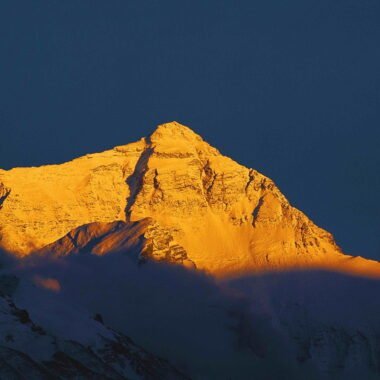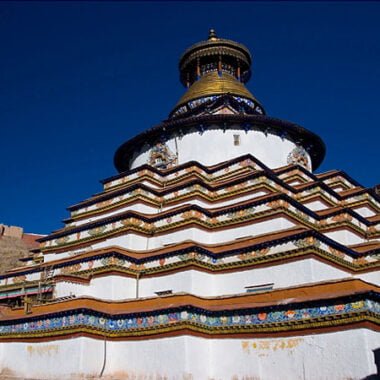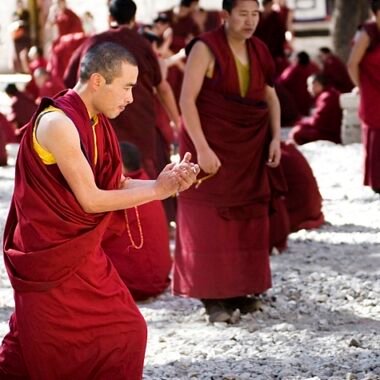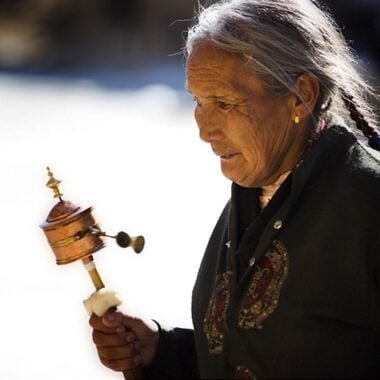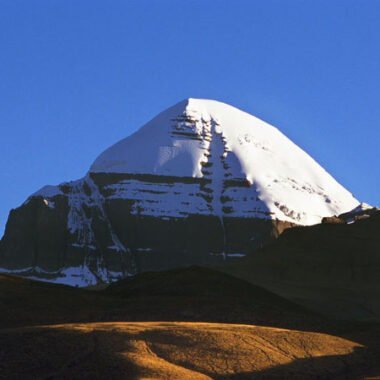7-Day Lhasa – Mount Everest – Kathmandu Overland Tour
$999.00 excluding flights & trains to/from Lhasa
✔ Customized Itinerary
✔ Private Transportation, Travel at Your Own Pace
✔ One-on-One Service from a Professional Tibetan Guide
✔ Complete Privacy, Comfortable and Convenient
✔ Flexible Travel Dates that work best for you
✔ Free Upgrade of Accommodation whenever possible
+ Small Group Tour Options Available
Lhasa – Gyantse – Shigatse – Mt. Everest – Kathmandu
Any Group Size are welcome, starting from just 1 person
Discover the Majestic Himalayas
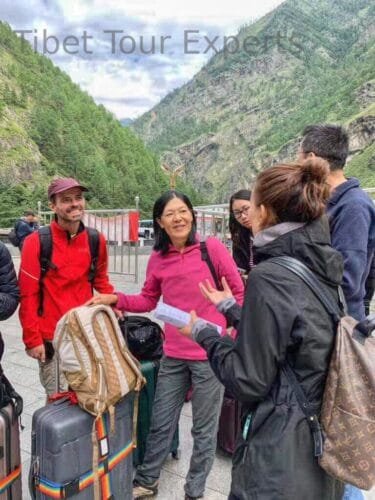
Embark on this extraordinary journey and create memories that will last a lifetime. From the wonder of Lhasa’s sacred sites to the awe-inspiring grandeur of Everest, and finally to the bustling streets of Kathmandu, this 7-day tour offers adventure, discovery, and cultural immersion in the heart of the Himalayas.
This tour can start in Lhasa and end at the Nepal border, where you will continue your journey to Kathmandu, or you can opt for the reverse direction—starting in Kathmandu and ending in Lhasa. Our guide will meet you at the Nepal border for seamless transition. We can also arrange private transfers between the Nepal border and Kathmandu, or from Kathmandu to the border, ensuring your comfort throughout the journey.
Tips: Starting in Lhasa is more favorable for acclimatization. Lhasa, at an elevation of 3,650 meters, offers better facilities, including hotels, medical services, and other amenities. On the other hand, the border areas are mostly situated at over 4,000 meters, where the conditions and services are more limited. Therefore, for better acclimatization and comfort, we recommend starting your journey in Lhasa if possible.
Tour Map
Highlights:
- Explore Potala Palace – Marvel at Tibet’s iconic architectural wonder and the residence of the Dalai Lama.
- Visit Jokhang Temple – Step inside Tibet’s most sacred temple, where devout pilgrims gather daily.
- Stroll Around Barkhor Street – Walk through the bustling market and join locals in their daily kora (pilgrimage circuit).
- Discover Drepung Monastery – Explore one of Tibet’s largest monasteries with rich history and stunning views of Lhasa.
- Witness Monastic Debates at Sera Monastery – Experience the lively philosophical debates among Buddhist monks.
- Cross Scenic Passes – Drive through breathtaking passes like Karo La and Gyatso La, with panoramic views of the Himalayas.
- Stop at the Gawu La Pass – Enjoy an unforgettable view of five of the world’s tallest peaks, including Everest.
- Admire Yamdrok Lake – Take in the serene beauty of one of Tibet’s holiest lakes, set against snow-capped mountains.
- Explore Gyantse’s Pelkor Monastery – See the unique fusion of Tibetan and Han architecture and the stunning Kumbum Stupa.
- Visit Tashilhunpo Monastery in Shigatse – The seat of the Panchen Lama, offering a spiritual and historical experience.
- Visit Rongbuk Monastery – The highest monastery in the world, offering incredible views of Everest.
- Experience Everest Base Camp – Stand at the foot of the world’s highest mountain, with jaw-dropping views of Mount Everest.
- On your journey to the border, enjoy the pristine beauty of Tibet’s untouched landscapes incl. the stunning view of Pelkutso Lake and Mount Shishapangma.
- Visit a Local Tibetan Family – Immerse yourself in traditional Tibetan life with a visit to a family home, sharing stories and local customs.
- Relax in a Tibetan Teahouse – Sip butter tea in a traditional teahouse, sampling authentic Tibetan butter tea.
- Witness the changing landscapes from Tibet to Nepal, from alpine terrain to lush valleys
Itinerary
Upon arriving in Lhasa, the sacred capital of Tibet, you will be transferred to your hotel. Take the day to rest and adjust to the high altitude. A stroll around the streets of Lhasa will introduce you to the city’s unique atmosphere, filled with prayer flags fluttering in the breeze and the scent of incense in the air.
Optional: Depending on your flight time or your acclimatization, this evening, you can take a peaceful stroll around the tranquil Dragon King Pond Park, a hidden gem near the Potala Palace. It’s a serene place where locals come to relax, surrounded by fluttering prayer flags and birds circling overhead. The pond offers a unique vantage point to photograph the Potala Palace from a different angle, bathed in the golden hues of sunset.
Tips: When you first arrive in Lhasa, we kindly suggest skipping the shower if you can, and taking it easy. During the whole trip, always walk slowly, drink plenty of water, and keep a calm and positive mindset. Remember to respect local customs and soak in the incredible beauty of this sacred plateau. Doing so will make your journey in Tibet feel even more comfortable, special and memorable.
Overnight Hotel in Lhasa
Begin your Tibetan journey with a visit to the Potala Palace, Tibet’s iconic landmark and the winter residence of the Dalai Lamas. Its massive structure towers over Lhasa, offering panoramic views of the city and surrounding mountains. Continue to the spiritual heart of Tibet, Jokhang Temple, where devoted pilgrims make their kora (circumambulation). Then explore the bustling Barkhor Street, filled with traditional Tibetan shops.
End the day relaxing at a traditional Tibetan teahouse, sipping and enjoying the special favor of Tibetan butter tea.
Overnight Hotel in Lhasa [Breakfast]
Start the day with a visit to Drepung Monastery, once the largest monastery in the world, home to thousands of monks and a vital center of learning and spirituality. In the afternoon, head to Sera Monastery, where you can witness the lively debating sessions between monks, a unique tradition that blends intellect and spirituality in an exciting display.
At evening, pay a visit to a local Tibetan family, sharing stories and local customs.
Overnight Hotel in Lhasa [Breakfast]
This morning, you’ll depart from Lhasa, driving through the stunning Tibetan countryside. The first stop is the sacred Yamdrok Lake, its turquoise waters set against the backdrop of towering snow-capped mountains. Continue over the Karo La Pass (5,036m), where you can view the massive Karo La Glacier at the road side. When arrive in Gyantse. visit the impressive Gyantse Kumbum Stupa before proceeding to Shigatse, the second-largest city in Tibet.
Overnight Hotel in Shigatse [Breakfast]
Today, you’ll drive to Everest Base Camp, passing through the Gyatso La and Gyawu La passes, which offer panoramic views of the Himalayan range, including Mount Everest. Upon arrival at Rongbuk Monastery, the highest monastery in the world, take in the jaw-dropping views of Mt. Everest. And at night, you may enjoy the glistening Milky Way stretching across the sky alongside the snow peak of Mount Everest creating a surreal and magical atmosphere.
Overnight Guesthouse or Tent near Everest Base Camp [Breakfast]
Get up early in the morning to enjoy the stunning sunrise over the majestic Mt. Everest, a breathtaking experience that leaves a lasting impression. Then you’ll drive toward Gyirong, the border town to Nepal. En route, stop by Pekutso Lake, a stunning body of water with views of Mt. Shishapangma (8,027m) in the distance.
The road to Gyirong winds through dramatic valleys, with the altitude rapidly descending to about 2800m. Gyirong is a peaceful town surrounded by lush greenery and towering mountains. The contrast between the high-altitude barren beauty of Everest and the lush greenery of Gyirong is striking, making the journey both diverse and awe-inspiring.
Overnight Hotel at Gyirong
After crossing the border at Gyirong, you’ll be met by a private vehicle arranged by our trusted partners in Nepal. From the moment you enter Nepal, you’ll experience a smooth transition as our team ensures your comfort for the final leg of the journey. The scenic drive to Kathmandu takes you through lush valleys, winding roads, and vibrant villages, offering a glimpse of Nepal’s rich culture and natural beauty. Your wonderful Tibet Tour ends when arrive at your hotel in Kathmandu.
[Breakfast]
Price Details
Include:
- Accommodation at 3-star* standard hotels in Lhasa and Shigatse, guesthouse or tent near Mt. Everest Base Camp and a local hotel at the border
- Breakfasts included in the hotels
- One private vehicle and one experienced driver throughout the tour
- A Professional Tibetan English-speaking tour guide
- All necessary Tibet travel permits
- Entrance tickets to all listed attractions
- Tourist accident / casualty insurance
- Service charge and government tax
- Oxygen for emergency use
- Bottled mineral water
*We offer a free upgrade to 4-star hotels in Lhasa and Shigatse when available.
Not Include:
- International and domestic flights / trains
- Meals not mentioned above
- Tips for guide and driver
- Personal expenses like souvenirs, snacks, drinks etc.
Our Services Guarantee:
We pride ourselves on transparency. There are no hidden fees or surprise charges during your trip.
If you need to cancel your trip for any reason, we offer a full refund if the cancellation is made at least 3 months before the departure date.
As a trusted and experienced travel company, we have no difficulty in obtaining all the necessary Tibet travel permits for you. We guarantee that there will be no failure in securing your permits due to any fault on our part. With decades of experience in Tibet tourism, we have a flawless record in permit applications. Rest assured, you won’t need to worry about any documentation from our side.
Once your tour is confirmed, we promise not to cancel it last-minute, unless unforeseen circumstances beyond our control arise.
We have established long-term partnerships with many hotels in Tibet. Whenever possible, we offer complimentary hotel upgrades to enhance your comfort and overall experience.
We ensure that all transportation, accommodations, and activities meet the highest safety and health standards in Tibet, including measures for altitude sickness prevention.
Your tour guide and driver will be available 24/7 for support and assistance during the whole trip.
Travel Notes and Tips
Comparetively speaking, the ideal seasons to visit Everest Base Camp are spring (April to June) and autumn (September to October), when the weather is generally clear and stable, providing good visibility of Mount Everest. While summer (July-August) is the rainy season, most rain falls at night, leaving daytime clear and pleasant.
And winter (November to March) offers low temperatures but often very clear skies, allowing for spectacular views of the stars and the Milky Way. Traveling during the winter off-season can also help you lower the tour prices.
The direct distance from Lhasa to Everest Base Camp is roughly 450 kilometers; however, the winding mountain roads make the actual driving distance approximately 700 kilometers. The journey typically takes around 14 hours of travel time. To ensure comfort and safety, we recommend breaking the trip into two days, allowing for better acclimatization and the chance to appreciate the scenic views along the way.
In cities like Lhasa and Shigatse, you can choose from a variety of accommodations, ranging from luxury hotels to budget guesthouses based on your preferences. At Everest Base Camp, lodging consists of basic tent guesthouses with shared facilities. And these may close during winter, requiring stays in nearby towns / villages like Tashi Dzom or Basong.
Dining options along the route include Tibetan and Sichuan restaurants, ensuring diverse choices to satisfy different tastes, including vegetarian options.
Everest Base Camp on the Tibetan side is located at approximately 5,200 meters (17,060 feet). First-time visitors to high altitudes may experience mild altitude sickness symptoms like dizziness or headaches. Our carefully crafted 8-day itinerary allows for 2-3 acclimatization days in Lhasa, at an altitude of 3,650 meters, before ascending to higher elevations, which helps mitigate severe altitude reactions. Should serious symptoms arise, such as intense headaches or difficulty breathing, use oxygen immediately, inform your guide, and seek medical help. If necessary, we can arrange for an urgent descent to lower altitudes like Shigatse or Tingri.
There may be times when Mount Everest isn’t visible due to unpredictable weather, though this is rare. To maximize your chances of seeing the mountain, plan your visit during the spring, autumn and winter months when conditions are more favorable. Our itinerary allows multiple opportunities to view Everest, and even if weather conditions obscure it, take the time to enjoy Tibet’s stunning landscapes. Please remember, the journey is about more than just Everest; it’s an adventure through remarkable natural beauty of the highest plateau in the world.
The following documents are required for foreign tourists to travel to Tibet Everest Base Camp: Passport, Chinese Visa, Tibet Travel Permit (also called Tibet Entry Permit, which will be required for boarding the train / flight to Lhasa), and Alien’s Travel Permit (which is usually handled after you arrive in Tibet with your original passport).
Note: Tourists from HongKong, Macau and Taiwan needs different travel documentation. Please feel free to contact us for more info.
It is necessary to provide photos or photocopies of your valid passport and Chinese Visa to apply for the Tibet Travel Permit. Those on a working visa need to include a work certificate, while student visa holders must provide student documentation. Taiwanese tourists only need photos or photocopies of their Mainland Travel Permit. The permit processing generally takes 7-14 working days, and once approved, we’ll send it to your address in mainland China (such as your hotel address) 3-5 days before your trip. You’ll need to show this permit for boarding the flight / train to Lhasa.
- Clothing: Bring thermal underwear, warm sweaters or fleece, and a thick down jacket. Windproof pants and thermal leggings are advisable. Sturdy hiking boots, scarves, gloves, and hats are essential for layering.
- Personal Items: Include skincare products (cleanser, moisturizer, lip balm, sunscreen), hygiene essentials (toothpaste, toothbrush, towel), and sunglasses for sun protection. A U-shaped pillow can add comfort during long travels, along with a thermal flask for hot water.
- Common Medications: Pack band-aids, motion sickness tablets, cold remedies, gastrointestinal aids, altitude sickness medication, and any personal prescriptions.
- Electronics: Bring chargers, power banks, cameras, and earphones as needed.
- Cash and Cards: While mobile payments are growing, having some cash and a bank card is wise for purchases in more remote areas.
Everest Base Camp currently has 5G coverage; however, WiFi is not available. Mobile networks can be used for communication, but high altitude may lead to slower speed or unstable connections. It’s best to download important apps in advance and inform family and friends about potential delays in responding to messages during your trip.
Travel Notes and Tips
The best seasons for this tour are spring (April to early June) and autumn (September to October) due to the pleasant weather, stable temperatures, and minimal rainfall. During these times, the chances of seeing Mount Everest clearly are higher.
Winter is also a great season for clear mountain views, especially of the Himalayas. Plus, as it’s the off-season for tourism, you’ll benefit from lower prices. In summer (July and August), while Tibet experiences some rain, it mainly occurs at night, so daytime activities aren’t usually affected. However, the roads in Nepal can be impacted by heavy rains, causing possible landslides and roadblocks.
You’ll need a Chinese Visa and a Tibet Travel Permit to enter the Tibet Autonomous Region.
Other documents, like the Alien’s Travel Permit for regions outside Lhasa, can be arranged once you arrive in Tibet.
As part of our service, we will handle the Tibet Travel Permit and other necessary local permits. Just follow our instructions, and there’s no need to worry about the paperwork.
To enter Nepal, you’ll need a Nepal Visa, which can be obtained at the border for $30 USD (for a 15-day visa). Be sure to have the fee ready in cash.
After booking the Lhasa to Kathmandu tour with us, you’ll need to send scanned copies of your Chinese Visa and valid passport (with at least six months’ validity).
If you’re in China on a work visa, you’ll also need proof of employment, while a student visa requires proof of your studies.
It generally takes 7-14 business days to process the Tibet Travel Permit. Once issued (usually 3-5 days before the tour date), we will send it to your address in mainland China, such as your hotel, ensuring you have it in time for your journey.
To ensure everything goes smoothly, it’s best to book your tour at least 15-20 days before departure.
Booking 1-2 months or even earlier can help us secure necessary travel permits and make accommodation reservations well in advance.
Early bookings may also allow you to take advantage of special discounts. The sooner you confirm your trip, the better prepared you’ll be without the stress of last-minute arrangements.
Due to high altitude and unpredictable weather, Mount Everest’s summit may not always be visible. However, our itinerary includes four different opportunities to catch a glimpse of it along the way, increasing your chances.
For the best odds, plan your visit during spring or autumn when the weather is more predictable. Our travel team can provide up-to-date weather conditions as you plan your tour. Regardless, stay positive and enjoy the journey. The stunning landscapes and the adventure itself are rewarding even if Everest remains hidden on the day of your visit.
The majority of the road from Lhasa to Gyirong Port at the China-Nepal border is paved and in good condition, covering about 820km.
However, once you cross into Nepal, the road leading to Kathmandu (about 180 km) can be dusty, rough, and bumpy. Despite these road conditions, the scenic views along the way are breathtaking. Our experienced local drivers are highly familiar with the terrain and will ensure your journey is safe and comfortable.
Everest Base Camp on the Tibetan side is located at approximately 5,200 meters (17,060 feet). First-time visitors to high altitudes may experience mild altitude sickness symptoms like dizziness or headaches. Our carefully crafted 7-day itinerary allows for 2-3 acclimatization days in Lhasa, at an altitude of 3,650 meters, before ascending to higher elevations, which helps mitigate severe altitude reactions. Should serious symptoms arise, such as intense headaches or difficulty breathing, use oxygen immediately, inform your guide, and seek medical help. If necessary, we can arrange for an urgent descent to lower altitudes like Tingri.
- Clothing: Bring thermal underwear, warm sweaters or fleece, and a thick down jacket. Windproof pants and thermal leggings are advisable. Sturdy hiking boots, scarves, gloves, and hats are essential for layering.
- Personal Items: Include skincare products (cleanser, moisturizer, lip balm, sunscreen), hygiene essentials (toothpaste, toothbrush, towel), and sunglasses for sun protection. A U-shaped pillow can add comfort during long travels, along with a thermal flask for hot water.
- Common Medications: Pack band-aids, motion sickness tablets, cold remedies, gastrointestinal aids, altitude sickness medication, and any personal prescriptions.
- Electronics: Bring chargers, power banks, cameras, and earphones as needed.
- Cash and Cards: While mobile payments are growing, having some cash and a bank card is wise for purchases in more remote areas.
Everest Base Camp currently has 5G coverage; however, WiFi is not available. Mobile networks can be used for communication, but high altitude may lead to slower speed or unstable connections. It’s best to download important apps in advance and inform family and friends about potential delays in responding to messages during your trip.



